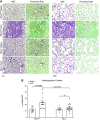PTPα promotes fibroproliferative responses after acute lung injury
- PMID: 35670474
- PMCID: PMC9255711
- DOI: 10.1152/ajplung.00436.2021
PTPα promotes fibroproliferative responses after acute lung injury
Abstract
The acute respiratory distress syndrome (ARDS) is a major healthcare problem, accounting for significant mortality and long-term disability. Approximately 25% of patients with ARDS will develop an overexuberant fibrotic response, termed fibroproliferative ARDS (FP-ARDS) that portends a poor prognosis and increased mortality. The cellular pathological processes that drive FP-ARDS remain incompletely understood. We have previously shown that the transmembrane receptor-type tyrosine phosphatase protein tyrosine phosphatase-α (PTPα) promotes pulmonary fibrosis in preclinical murine models through regulation of transforming growth factor-β (TGF-β) signaling. In this study, we examine the role of PTPα in the pathogenesis of FP-ARDS in a preclinical murine model of acid (HCl)-induced acute lung injury. We demonstrate that although mice genetically deficient in PTPα (Ptpra-/-) are susceptible to early HCl-induced lung injury, they exhibit markedly attenuated fibroproliferative responses. In addition, early profibrotic gene expression is reduced in lung tissue after acute lung injury in Ptpra-/- mice, and stimulation of naïve lung fibroblasts with the BAL fluid from these mice results in attenuated fibrotic outcomes compared with wild-type littermate controls. Transcriptomic analyses demonstrate reduced extracellular matrix (ECM) deposition and remodeling in mice genetically deficient in PTPα. Importantly, human lung fibroblasts modified with a CRISPR-targeted deletion of PTPRA exhibit reduced expression of profibrotic genes in response to TGF-β stimulation, demonstrating the importance of PTPα in human lung fibroblasts. Together, these findings demonstrate that PTPα is a key regulator of fibroproliferative processes following acute lung injury and could serve as a therapeutic target for patients at risk for poor long-term outcomes in ARDS.
Keywords: ARDS; PTPα; acute lung injury; fibroproliferative ARDS.
Conflict of interest statement
No conflicts of interest, financial or otherwise, are declared by the authors.
Figures







References
-
- Acute Respiratory Distress Syndrome N, Brower RG, Matthay MA, Morris A, Schoenfeld D, Thompson BT, Wheeler A. Ventilation with lower tidal volumes as compared with traditional tidal volumes for acute lung injury and the acute respiratory distress syndrome. N Engl J Med 342: 1301–1308, 2000. doi:10.1056/NEJM200005043421801. - DOI - PubMed
-
- National Heart L, Blood Institute Acute Respiratory Distress Syndrome Clinical Trials N, Wiedemann HP, Wheeler AP, Bernard GR, Thompson BT, Hayden D, deBoisblanc B, Connors AF Jr, Hite RD, Harabin AL. Comparison of two fluid-management strategies in acute lung injury. N Engl J Med 354: 2564–2575, 2006. doi:10.1056/NEJMoa062200. - DOI - PubMed
Publication types
MeSH terms
Substances
Associated data
Grants and funding
LinkOut - more resources
Full Text Sources
Medical
Molecular Biology Databases

